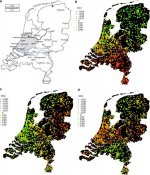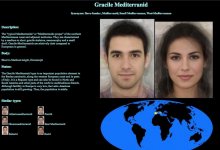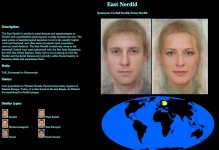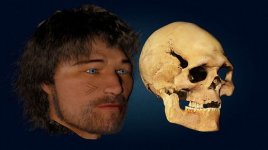Northener
Elite member
- Messages
- 2,008
- Reaction score
- 522
- Points
- 113
- Location
- Groningen
- Ethnic group
- NW Euro
- Y-DNA haplogroup
- E1b1b/ E-V22
Phenotypes and races
Phenotypes of Europe are easily found on the internet. Unfortunately, it mostly consists in recycling of altered mid twentieth century phenotyping of Carleton Coon (1904-1981), Bertil Lundman (1899-1993) or much older anthropologist.
The mayor wrong assumption of them was that phenotypes (physical appearance) represent different ‘races’. Phenotypes supposed to be clear differentiated genetic phenomenon. Also some kind of frozen products of the past. According to Coon a Borreby is a large headed ‘pure Palaeolithic survivor’. Modern genetic research swept away those assumptions. No evidence for race, racial based phenotypes or whatsoever. Partly as a result of this more fuzzy than clear defined reality phenotyping has never led to a basic agreement about the different phenotypes.
So phenotypes are nonsense? As clear defined racial based stereotype: yes. But that’ s not the whole story. When we visit the different regions of the world than amidst all the differential shaped faces and body’s, in this grid, we can recognize some loose shaped patterns. Some physical appearances do more often occur in certain regions. And of course these phenotypes have a basis in the genotype. But they are never 1:1. Migration patterns, founder effects and marked geographic barriers have shaped different regional clusters or clines, and therefore different “regional faces.”(see: Barbujani 2010).
For Europe as a whole the only thing you can reasonable state is there is some kind of phenotype difference between Northern and Southern Europe whereby the Northerners usually have lighter features (light eyes, blonde hair, lighter skins) and are taller in stature than the Southerners.
Case: Northern Netherlands
But within this rough framework can there be more differentiated? I guess so. Then we must have a clear look on the different geographical situations and the migration patterns of the past. Therefore, I would like to zoom in on the situation in North-western Europe and specific the situation in the Northern parts of the Netherlands, the old Frisian-Saxon territory, mostly bordering the North Sea.
The Northern Netherlands are not only marked by the North Sea, bordering in the Northern and Western part, but in the South it is marked by the grand river the Rhine. In the Roman days this was also the frontier of the Roman empire the so called “Limes”. Eastwards there are besides a relative small river like the Ems no clear barriers. This has major consequences.
This is shown in Abeld Abdellaoui e.a. article of 2013 called Population structure, migration, and diversifying selection in the Netherlands (2013). Based on the 1000 gnomes project, important conclusions were drawn.
This essence is shown in this picture:

Here is a clear difference between three regionally different gene pools in the Dutch situation:
When we zoom in on the North, this is clearly a part of Northwest Europe as a whole. More specific: the North Sea Region (= Southwestern Scandinavia, Northwestern Germany and England).
Four migration waves
The Northwest European gene pool is determined by the following four founding "migratory waves":
1. The hunter-gatherers, after the last ice age. About 19,000 years ago the hunter-gatherers who had been hiding during the ice age in southern resorts of Europe, (back) to Northwest Europe. At the end of this period they were in the northern Netherlands Europe Ertebølle or also Swifterbant culture (4900-3350 BC.), With the first signs of agriculture.Eight years ago, according to the genome project in the Netherlands but to relate much as 78% of the Dutch to this group (more on that later). Cro Magnons were tall, robust, great headed. This group occurred first movements towards blue eyes, often in combination with a rather dark skin and hair.

2. The first farmers of the Neolithic, coming from the eastern part of the Mediterranean (Anatolia e.o), both from coast to coast and through the rivers, north westward. These groups were genetically different from the hunter-gatherers in Northwest Europe. They settled in the first period probably detached from the indigenous hunter-gatherers, both groups gradually became intermingled. Of course differentiated by subregion. It is also possible that hunter-gatherers acquired the farming. Their appereance of the first farmers was quite different from the hunter-gatherers, more gracile dark hair and eyes, but with a much lighter skin than the hunter-gatherers

The current Sardinians still seem to have the most affinity with this group. Their share in the Dutch ancestors were estimated eight years ago about 20%.
Pontus Skoglund has this genetic development (incoming farmers first unconnected with the indigenous population) outlined the Funnel Beaker Culture (3350 BC- 2750 BC.) The Northern Netherlands were an integral part of it and was the westernmost offshoot of this culture. See: http://dienekes.blogspot.nl/2014/04/more-ancient-scandinavians-skoglund.html
3. The rise of the Indo European Warriors in the Bronze Age.
The Funnel Beaker Culture (South Scandinavia, northern Germany and northern Netherlands) was in the Bronze Age followed by new types of Beakerfolk ending with the Elpculture (around 800 BC.). In the Iron Age followed by Harpstedt-Nienburg group. This is most likely to mixed groups but one thing is clear: the latest genetic impulses came from the East herein, originally from the Pontic steppe. This is often associations are established with lighter, long types are mainly found along the Baltic coast:
 .
.
These people have brought haplotype R1b (and R 1a) to this region. In the year 2016 about 60% of Northern Dutch men have this haplotype. It is therefore the extent to which it corresponds to the outcome of the Dutch gnome research (78% of Dutch men can be traced back to the hunter-gatherers) eight years ago because R1b came in the Bronze Age to Northwest Europe. In essence, these three waves determined the gene pool of the Northern Netherlands. For North Netherlands there is still a significant "internal" Northwest European movement:
4. The spread of the Saxons, during the migrations of the 4th and 5th centuries AD. The spread of the Angles and Saxons, peoples from the current Schleswig-Holstein, is usually associated with England. But this is also true for the Frisian Northsea coast. It is an archaeological fact that the Northern mounds largely (current Friesland), partly (current Groningen) and to a small extent (present Ost-Friesland) were abandoned after the fall of the Roman Empire. This area shows no significant activity on the 'archaeological radar’. Newcomers from the high North had relatively free reign. Their contribution has been particularly strong in Westergo, near the Frisian capital of Leeuwarden. Westergo was in the centuries that followed very rich and authoritative. Only from about the subjection to the Franks, the Frisians where back on track. So an old flag on a new ship.
There is some kind of 4b wave, because in the middle ages the people of the Northern Netherlands migrated to coastal North-western Gemany and the shaped the dikes and the marshes in these area. The Germans call it the Hollerkolonisation (after Holland, https://de.wikipedia.org/wiki/Hollerkolonisation).
Nordics altered by Cro-magnoid or the Northsea Phenotype
These developments show that in the North Sea region, the major grid, or phenotype is the one who is described by Coon as a ‘mixed’ type of ‘overgrown Nordics’. So within the overall Northern European (light and tall) phenotype this subtype is more than average tall, broad-shouldered, with a larger head and face, as well as more than average-sized hands and feet. This is the dominant phenotype of the Northsea area:
(see next post!)
Of course this certainly doesn’t exclude darker, smaller featured phenotypes in this area. But what it does exclude is the ‘pure’ phenotypes of Coon like Borreby or Brunn. Or as the Guardian stated on the first of march 2015:
‘Our DNA is mixed and remixed through endless sex and continuous migration. We are too horny and mobile to have stuck to our own kind for very long.
Race doesn’t exist, racism does. But we can now confine it to opinions and not pretend that there might be any scientific validity in bigotry.’
Based mainly on:
Abeld Abdellaoui e.a. article of 2013 called Population structure, migration, and diversifying selection in the Netherlands (2013)
G. Barbujani and V. Colonna, ‘Human genome diversity: frequently asked questions’ in: Trends Genet. 2010 Jul;26(7):285-95
S.C. Coon The Races of Europe (New York 1948)
Torsten Günther & Mattias Jakobsson, Genes mirror migrations and cultures in prehistoric Europe - a population genomic perspective (1 Sept. 2016)
http://biorxiv.org/.../biorx.../early/2016/09/01/072926.full.pdf
Oost-friese landschap, Land van ontdekkingen, archeologie van het Friese kustgebied (2013)
Phenotypes of Europe are easily found on the internet. Unfortunately, it mostly consists in recycling of altered mid twentieth century phenotyping of Carleton Coon (1904-1981), Bertil Lundman (1899-1993) or much older anthropologist.
The mayor wrong assumption of them was that phenotypes (physical appearance) represent different ‘races’. Phenotypes supposed to be clear differentiated genetic phenomenon. Also some kind of frozen products of the past. According to Coon a Borreby is a large headed ‘pure Palaeolithic survivor’. Modern genetic research swept away those assumptions. No evidence for race, racial based phenotypes or whatsoever. Partly as a result of this more fuzzy than clear defined reality phenotyping has never led to a basic agreement about the different phenotypes.
So phenotypes are nonsense? As clear defined racial based stereotype: yes. But that’ s not the whole story. When we visit the different regions of the world than amidst all the differential shaped faces and body’s, in this grid, we can recognize some loose shaped patterns. Some physical appearances do more often occur in certain regions. And of course these phenotypes have a basis in the genotype. But they are never 1:1. Migration patterns, founder effects and marked geographic barriers have shaped different regional clusters or clines, and therefore different “regional faces.”(see: Barbujani 2010).
For Europe as a whole the only thing you can reasonable state is there is some kind of phenotype difference between Northern and Southern Europe whereby the Northerners usually have lighter features (light eyes, blonde hair, lighter skins) and are taller in stature than the Southerners.
Case: Northern Netherlands
But within this rough framework can there be more differentiated? I guess so. Then we must have a clear look on the different geographical situations and the migration patterns of the past. Therefore, I would like to zoom in on the situation in North-western Europe and specific the situation in the Northern parts of the Netherlands, the old Frisian-Saxon territory, mostly bordering the North Sea.
The Northern Netherlands are not only marked by the North Sea, bordering in the Northern and Western part, but in the South it is marked by the grand river the Rhine. In the Roman days this was also the frontier of the Roman empire the so called “Limes”. Eastwards there are besides a relative small river like the Ems no clear barriers. This has major consequences.
This is shown in Abeld Abdellaoui e.a. article of 2013 called Population structure, migration, and diversifying selection in the Netherlands (2013). Based on the 1000 gnomes project, important conclusions were drawn.
This essence is shown in this picture:

Here is a clear difference between three regionally different gene pools in the Dutch situation:
- North (East) Netherlands (above the Rhine)
- South of the Netherlands (down the Rhine)
- West Netherlands (so called Randstad Holland with Amsterdam/Rotterdam etc.) as a mixture of a and b. The latter mainly because of the pivotal role and appeal from the Dutch Golden Age (seventeenth century) and beyond.
When we zoom in on the North, this is clearly a part of Northwest Europe as a whole. More specific: the North Sea Region (= Southwestern Scandinavia, Northwestern Germany and England).
Four migration waves
The Northwest European gene pool is determined by the following four founding "migratory waves":
1. The hunter-gatherers, after the last ice age. About 19,000 years ago the hunter-gatherers who had been hiding during the ice age in southern resorts of Europe, (back) to Northwest Europe. At the end of this period they were in the northern Netherlands Europe Ertebølle or also Swifterbant culture (4900-3350 BC.), With the first signs of agriculture.Eight years ago, according to the genome project in the Netherlands but to relate much as 78% of the Dutch to this group (more on that later). Cro Magnons were tall, robust, great headed. This group occurred first movements towards blue eyes, often in combination with a rather dark skin and hair.

2. The first farmers of the Neolithic, coming from the eastern part of the Mediterranean (Anatolia e.o), both from coast to coast and through the rivers, north westward. These groups were genetically different from the hunter-gatherers in Northwest Europe. They settled in the first period probably detached from the indigenous hunter-gatherers, both groups gradually became intermingled. Of course differentiated by subregion. It is also possible that hunter-gatherers acquired the farming. Their appereance of the first farmers was quite different from the hunter-gatherers, more gracile dark hair and eyes, but with a much lighter skin than the hunter-gatherers

The current Sardinians still seem to have the most affinity with this group. Their share in the Dutch ancestors were estimated eight years ago about 20%.
Pontus Skoglund has this genetic development (incoming farmers first unconnected with the indigenous population) outlined the Funnel Beaker Culture (3350 BC- 2750 BC.) The Northern Netherlands were an integral part of it and was the westernmost offshoot of this culture. See: http://dienekes.blogspot.nl/2014/04/more-ancient-scandinavians-skoglund.html
3. The rise of the Indo European Warriors in the Bronze Age.
The Funnel Beaker Culture (South Scandinavia, northern Germany and northern Netherlands) was in the Bronze Age followed by new types of Beakerfolk ending with the Elpculture (around 800 BC.). In the Iron Age followed by Harpstedt-Nienburg group. This is most likely to mixed groups but one thing is clear: the latest genetic impulses came from the East herein, originally from the Pontic steppe. This is often associations are established with lighter, long types are mainly found along the Baltic coast:
 .
.These people have brought haplotype R1b (and R 1a) to this region. In the year 2016 about 60% of Northern Dutch men have this haplotype. It is therefore the extent to which it corresponds to the outcome of the Dutch gnome research (78% of Dutch men can be traced back to the hunter-gatherers) eight years ago because R1b came in the Bronze Age to Northwest Europe. In essence, these three waves determined the gene pool of the Northern Netherlands. For North Netherlands there is still a significant "internal" Northwest European movement:
4. The spread of the Saxons, during the migrations of the 4th and 5th centuries AD. The spread of the Angles and Saxons, peoples from the current Schleswig-Holstein, is usually associated with England. But this is also true for the Frisian Northsea coast. It is an archaeological fact that the Northern mounds largely (current Friesland), partly (current Groningen) and to a small extent (present Ost-Friesland) were abandoned after the fall of the Roman Empire. This area shows no significant activity on the 'archaeological radar’. Newcomers from the high North had relatively free reign. Their contribution has been particularly strong in Westergo, near the Frisian capital of Leeuwarden. Westergo was in the centuries that followed very rich and authoritative. Only from about the subjection to the Franks, the Frisians where back on track. So an old flag on a new ship.
There is some kind of 4b wave, because in the middle ages the people of the Northern Netherlands migrated to coastal North-western Gemany and the shaped the dikes and the marshes in these area. The Germans call it the Hollerkolonisation (after Holland, https://de.wikipedia.org/wiki/Hollerkolonisation).
Nordics altered by Cro-magnoid or the Northsea Phenotype
These developments show that in the North Sea region, the major grid, or phenotype is the one who is described by Coon as a ‘mixed’ type of ‘overgrown Nordics’. So within the overall Northern European (light and tall) phenotype this subtype is more than average tall, broad-shouldered, with a larger head and face, as well as more than average-sized hands and feet. This is the dominant phenotype of the Northsea area:
(see next post!)
Of course this certainly doesn’t exclude darker, smaller featured phenotypes in this area. But what it does exclude is the ‘pure’ phenotypes of Coon like Borreby or Brunn. Or as the Guardian stated on the first of march 2015:
‘Our DNA is mixed and remixed through endless sex and continuous migration. We are too horny and mobile to have stuck to our own kind for very long.
Race doesn’t exist, racism does. But we can now confine it to opinions and not pretend that there might be any scientific validity in bigotry.’
Based mainly on:
Abeld Abdellaoui e.a. article of 2013 called Population structure, migration, and diversifying selection in the Netherlands (2013)
G. Barbujani and V. Colonna, ‘Human genome diversity: frequently asked questions’ in: Trends Genet. 2010 Jul;26(7):285-95
S.C. Coon The Races of Europe (New York 1948)
Torsten Günther & Mattias Jakobsson, Genes mirror migrations and cultures in prehistoric Europe - a population genomic perspective (1 Sept. 2016)
http://biorxiv.org/.../biorx.../early/2016/09/01/072926.full.pdf
Oost-friese landschap, Land van ontdekkingen, archeologie van het Friese kustgebied (2013)
Attachments
Last edited:


